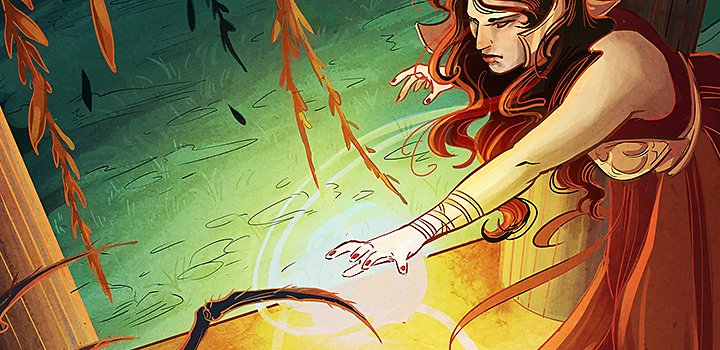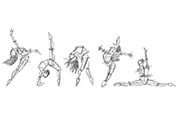Discover how to become a professional illustrator.
You’ve built your skills and created a body of work, but what’s next? Get tips on portfolio creation and art presentation to help you step into a creative field full-time.

Becoming a successful illustrator is about more than art.
Whether you’re just out of art school or simply looking for a new career path, making the leap into professional illustration is as much about presentation as it is about your work.
Determine an area of focus to help define your personal style.
Whether you want to pursue a career in book illustration, fine art, editorial illustration, or even drawing greeting cards, understanding your goals and honing your style to work toward them will help you give you focus.
“It’s 100 percent intent,” illustrator and comic book artist Jen Bartel says. “Many working illustrators aren’t the most technically skilled draftsmen, but they have solid and recognizable points of view — they have instantly identifiable work. If you want to pursue illustration as a career, the first thing that you need is a consistent body of work.”


While you may have the ability to do everything from realistic portraiture to surreal digital painting, sometimes that jack-of-all-trades approach can be misleading to potential clients and steer you away from what you really want to work on.
“I had a lot of clients who liked these fantasy illustration pencil renderings,” graphic novel creator Ethan Young says. “I didn’t dislike doing them, but my passion was elsewhere. Eventually, I decided, ‘I have to focus more on comics. That’s what I love to do.’”

How to build, and what to include in, a professional portfolio.
“If you want to make a career doing things you’re passionate about, curate a portfolio of the things you love the most,” artist Mildred Louis says. “Put the exact kind of work you want to keep doing in your portfolio.”
It’s simple but logical advice. Your portfolio is your creative resume, so demonstrate and display the work you want to get hired to do. And while you may need to take jobs for financial reasons that don’t align with your creative goals, it’s important to keep your eye on the prize when crafting a portfolio. Bartel, who worked on art in other fields before her career in comics, explains how building your portfolio can help.
“Put the exact kind of work you want to keep doing in your portfolio.”
“In my case, I knew that I wanted to do comic covers, so I went out of my way to create illustrations that looked like comic covers,” she says.
It’s your career, so set yourself up for what you want. Narrowing the focus of your portfolio can help an art director pinpoint your specialty, but if you want to work on diverse projects, you may take a different approach.
“I want to show a breadth of work,” designer and illustrator Lenore Ooyevaar says. “I want to show that I can do a variety of things, so that I’ll get more varied projects.”

Here are a few additional tips when it comes to creating portfolios:
1. Availability: A professional portfolio you can pass to potential clients is important, but having work available online in a portfolio website is important for building a client base. Make sure it features recent work that you think reflects your abilities — work you’d like to be hired for — and be sure to list your current contact information.
2. Type of work: Focusing on a type of work will tell potential employers what you specialize in. If you choose to showcase a broader set of work, make sure it’s work you’d like to potentially get hired to do. A portfolio is like a menu — only list what you want someone to order.
3. Accessibility: Art directors are busy people and may spend only a short amount of time initially perusing a portfolio. That makes using full-size artwork (instead of thumbnails that must be clicked) on your portfolio site important. Also make sure the file sizes are sitio web-optimized so the images load quickly.
4. Measuring expectations: While a piece that took you months to complete will demonstrate your skill, it may not be a realistic demonstration of work you can do on a deadline. But also, don’t post subpar work just to add more content. “If you’re just starting out and you don’t have a lot of work, still only show your very best stuff,” Ooyevaar says. “Don’t go for quantity over quality.”
If you need more guidance, check out illustration portfolios by artists in the Behance community for inspiration and professional direction — and once you’re ready, share your own. Or use this tutorial to get things rolling:

Taking the time to set up a good portfolio site will pay off, especially as it’s often the main consideration when it comes to being hired.
“When you are working freelance in creative industries, there is no interview,” Bartel explains. “The mentality is, ‘Prove to me you can do this through your portfolio and I’ll hire you.’ The art is your interview.”
Things to keep in mind when working with clients and art directors.
While a developed and polished portfolio will help your cause, networking to land a gig will take a huge amount of effort. From literally knocking on doors to sending out dozens of pitch emails, all while trying to build a social media following, connecting with art directors and hiring managers — or working to get yourself an agent — will take a lot of hustle.
Once you’ve been hired, your next step is managing client communication, from their expectations to trying to discern exactly what they want you to do.
“It’s so important to fully understand what the client wants and for the client to fully understand what the illustrator is going to provide,” Ooyevaar says. “I’ve been in situations where either my client didn’t really articulate what they wanted or they didn’t know what they wanted. So I made assumptions and I didn’t quite explain clearly what I would be providing. Transparency and being really clear to set expectations is super important.”
“Hit your deadlines. That’s the number one reason why editors and art directors keep coming back to me.”
Understand that people looking to hire artists have a need. They may love your style, which leads to a conversation, but they might be looking for something very specific. This makes clear communication and asking a lot of questions even more essential.
“You are being called in to solve a specific problem,” Chris Kindred explains. “They know that you’re talented — otherwise they wouldn’t be emailing you. And if you are able to do what you do and do it very well, they will hit you up for something else in the future.”

And while art and illustration is a creative field, if you want to succeed in it, you need to be professional.
“Hit your deadlines. That’s the number one reason why editors and art directors keep coming back to me,” Bartel says. “Make sure you’re keeping your art director or editor updated. Communicate. If your roles were reversed, what would you appreciate?”
If you can communicate well and hit the mark — and do it on time — you’ll build a lot of momentum on your way from aspiring illustrator to busy professional artist. “You’re going to have to take freelance jobs that you’re not crazy about,” Louis says. “But as long as you’re staying focused on what makes you happy and what keeps you drawing, at the end of the day, that keeps you moving forward in life.” And with that momentum, careers are born.
Contributors
You might also be interested in…
Lleva tus habilidades al siguiente nivel con ejercicios de dibujo y consejos de ilustradores profesionales.
Lee una introducción al estilo de ilustración de los cómics japoneses.
Get tips on how to draw this challenging bit of human anatomy.
Exploración de las técnicas de color diluido.
Captura las pinceladas fluidas y la rica textura del color diluido con estos consejos.
Consigue Adobe Illustrator
Crea atractivos gráficos vectoriales e ilustraciones.
7 días gratis, luego Col$ 112.658 /mes.



